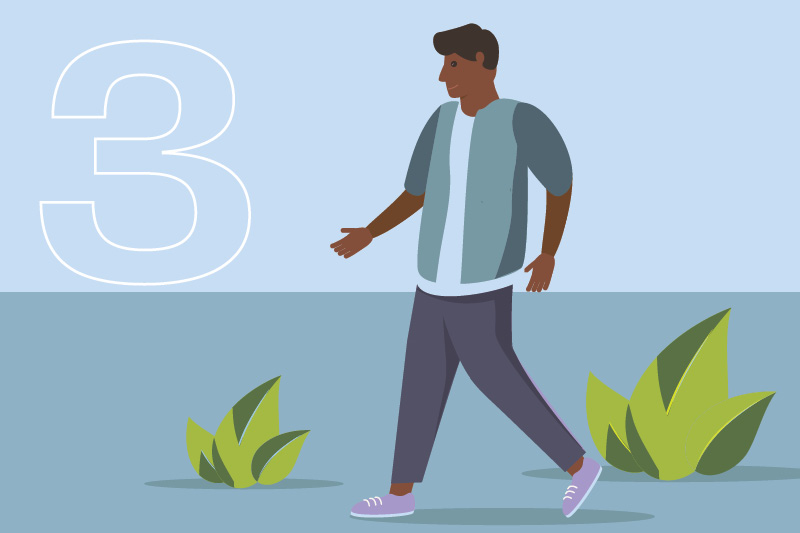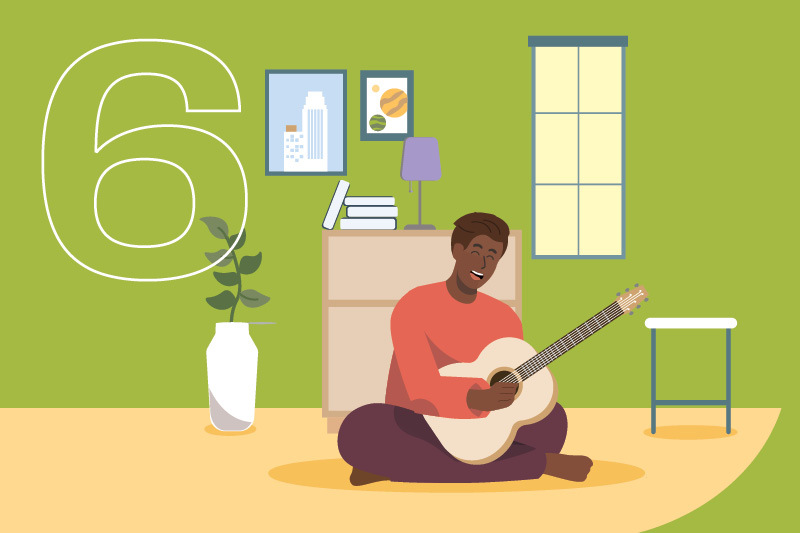
Wellness by Number
The pandemic set a lot of us on a quest for wellness. Falcons with health-related expertise rallied to the cause, with many hosting virtual presentations sponsored by the Office of Alumni and Family Engagement. Here’s some of their best advice for staying well in body, mind and spirit.
 Six Paths to a Happy Gut
Six Paths to a Happy Gut
Deanna Rose Ahigian ’10 is a licensed herbalist and the founder of Indigo Elixirs. She routinely helps clients find digestive wellness for better health.
-
Choose foods that are closest to how they are found in nature. Infuse your diet with fresh herbs, dried spices and seaweeds, as well as fermented foods such as kraut and kimchi to help gut flora thrive.
-
Eat prepared foods only in moderation, and avoid highly processed food altogether.
-
Practice good posture while eating, chew food to a mush before swallowing, and enjoy drinks before or after your meal. If necessary, take small sips of water while you eat.
-
Keep meals simple, limiting the number of ingredients, but varying what you eat at each meal to make sure you get the full range of nutrients needed for good health.
-
Aim for a warm, simple meal such as oatmeal for breakfast. Consume any raw or cold foods at lunchtime, when your digestive system is most active. End the day with a cooked, nourishing meal at least three hours before bedtime.
-
Track what you eat. Note when you feel heavy, bloated or uncomfortable, and remove aggravating foods from your diet.
Watch the full presentation.
 Three Habits Wrecking Your Sleep
Three Habits Wrecking Your Sleep
You can achieve the dream of consistently refreshing sleep, says sleep wellness coach Kali Patrick, MSHFID ’04. Start by putting these bad behaviors to rest.
-
Using substances to help you sleep. Taking sleep aids, even natural ones such as melatonin, won’t address the root causes of insomnia and other sleep issues. Many substances are not intended for prolonged use and can create dependency (physiological or mental).
-
Failing to release or reduce excess energy. It should take 15 to 20 minutes to fall asleep, but many people find they just can’t shut down even after a bedtime routine. Certainly turn off TV and other screens well before bedtime, but also be mindful of what kind and how much information stimulates you throughout your day. Notice which interactions with others rev you up. Practice setting healthy boundaries and release any extra energy through exercise and relaxation practices.
-
Believing your challenges with sleep are simply a nighttime problem. To get consistently refreshing sleep, it’s best to honor the natural ebbs and flows of energy throughout the day. Be mindful of your “rest rhythms.” Learn how to support yourself instead of powering through when your energy lulls.
Watch the full presentation.
 Six Strategies for Healthy Eating
Six Strategies for Healthy Eating
Making better food choices begins with planning, says exercise and nutrition coach Heather Buda ’08.
-
Understand the three foundational elements of healthy eating: complex carbs, which include fruits, vegetables, whole grains and legumes; healthy fats, especially Omega-3 and Omega-6; and lean proteins.
-
Hold ingredients to a minimum. The healthiest peanut butter, for example, contains only peanuts and salts.
-
Group foods into three categories — green, yellow, red — instead of “good” or “bad.” Eat yellow foods in moderation — a couple of times a week — and red only occasionally. The green light goes to lean proteins, vegetables, fruits, whole grains and healthy fats such as almonds and olives. Yellow foods include cottage cheese, flavored yogurt, granola and pancakes as well as certain fats such as coconut oil. The red category includes fried foods, sugar, butter and shortening. Pay attention to how a food makes you feel, limiting items that make you feel lousy.
-
Plan meals and snacks in advance, aiming for “green” foods to compose most of your diet.
-
Build a collection of favorite recipes to make meal planning quicker and easier. Program in personal preferences, such as favorite foods and a willingness to have leftovers. Vary flavors using spices, herbs and citrus, and repurpose leftovers, for example, salmon fillet one night, salmon burgers the next.
Watch the full presentation.
 Four Keys to Unlocking Creativity
Four Keys to Unlocking Creativity
Being creative is a natural mood booster. Author, speaker and comedian Bill Connolly ’10 urges people to find their inner Picasso, Mozart or Lenny Bruce.
-
Identify your own brand of creativity. If you struggle to name your creative talents, think about what you enjoy doing, how you stood out as a child, or what other people tell you you’re good at doing.
-
Create new routines and seek high-growth experiences that support and foster creativity. It’s all about breaking your usual scripts, learning new insights to apply to a creative outlet you already have. A singer, for example, might try a visual art for inspiration.
-
Take action. Some recognized strategies to pump up the creative juices are doing calisthenics, deliberately coming up with bad ideas, and engaging in a creative activity besides the one you want. Even small steps can move you toward your goals.
-
Find a community. Look for online or in-person groups that share your creative desire, with members who can inspire and work collaboratively with you.
Watch the full presentation.
 Five Building Blocks for Meaningful Connections
Five Building Blocks for Meaningful Connections
Relationship coach Molly Godfrey ’14 shares these insights for forging stronger connections with the people in your life.
-
Pay attention. When you’re with someone, whether a romantic partner or longtime friend, be fully present and genuinely curious about what they’re thinking and saying. Ask questions, listen and don’t let your mind drift to other thoughts. The quality of our attention is what determines the success of our relationships.
-
Say thanks. It’s important to notice and acknowledge all that other people do for you, whether that is making dinner — or the reservations. Don’t take such thoughtfulness for granted.
-
Share your thoughts and feelings. Too often we have the expectation that others can read our mind. Instead of relying on people to guess at what you’re thinking, offer what’s on your mind and give space to discuss it.
-
Have regular check-ins. Romantic partners should set aside a time each week to ask whether anything needs discussion or pinpoint areas that require more help and support. Friends, too, benefit from check-ins to make sure all is good; do so on a schedule that fits the relationship.
-
Connect “just because.” When someone crosses your mind, reach out and say, “Hey, I’m thinking of you.” It makes people feel chosen, acknowledged and a priority.
Watch the full presentation.
 Three Secrets to a Mindful Workday
Three Secrets to a Mindful Workday
How do you stay calm even in a stressful job? Career coach Alicia Ramsdell ’03, MST ’06, founder and CEO of Mindful Career Path, recommends these moves.
-
Pay attention to your breath. One option is the 4-7-8 technique, also known as “relaxing breath.” Breathe in, through the nose, for a mental count of four seconds; hold for a count of seven; and breath out, through the mouth, for eight. Breathing exercises can lower stress, reduce blood pressure and boost energy.
-
Consider the 5-4-3-2-1 coping technique. It can ground you in the present moment when your mind is bouncing between anxious thoughts. Start by acknowledging five things that you can see around you, then four things you can touch and actually touch them, then three things you can hear, two things you can smell and lastly one thing you can taste.
-
Start each day with mindfulness, movement and mindset. Cultivate mindfulness through meditation, for example, and movement through physical activity. Adjust mindset through affirmations. If you say something enough, your brain will start to believe it.
Watch the full presentation.
 Four Ways to Start Journaling for Self-Care
Four Ways to Start Journaling for Self-Care
Keeping a journal can help keep anxiety and depression at bay. Get started with these how-tos from Latonia Francois ’05, principal of Let’s Write Life.
-
Make journaling enjoyable. Write about aspects of your life that motivate you and reflect on the reasons that led you to want to write.
-
Use self-care prompts. For help in getting words on the page, look to guided journals or journaling inspiration online to determine how you might like to improve your self-care routines.
-
Keep it personal. Create a journaling practice that works for you. Write about what’s on your mind, without worrying about grammar or punctuation. Fill the pages with your life: words, photos, significant moments and more.
-
. . . and purposeful. Think about what you want to achieve — whether that is to vent and de-stress, track goals or work through ideas — and let that guide you. Doing so makes journaling that much more meaningful.
Watch the full presentation.
 Four Ways to Unplug
Four Ways to Unplug
Prithvi Kudva, MSHFID ’21 was surprised to learn how much time she spent checking Instagram — even on her busiest days as a grad student and staff member in Bentley’s User Experience Center. Here are her recommendations for a healthier relationship with digital devices.
-
Monitor how you spend your time using tech to gain insight into problem areas.
-
Identify your triggers. Ask yourself what makes you reach for your phone or favorite app. Is it boredom? Fear of missing out? Or something else?
-
Plan a redirect. To bypass the triggers that prompt you to mindlessly engage with the digital world, have a plan to redirect to activities that you prefer. For example, keep reading material close at hand, so you reach for a real book rather than scrolling through Facebook.
-
Turn the tables on technology. Look for built-in tools that let you obstruct or restrict access to the internet. Shut off notifications or turn on your phone’s gray scale to reduce temptation. Try apps that help you set and reach goals or those that provide a reward for hitting your targets.
Watch the full presentation.
 Six Routes to Everyday Happiness
Six Routes to Everyday Happiness
Senior Lecturer in Marketing Jim “Pouli” Pouliopoulos, MBA ’95 offers top takeaways from his co-authored book, How to Be a Well Being: Unofficial Rules to Live Every Day.
-
Recognize you can control your happiness by making conscious decisions every day about where to focus your attention.
-
Practice “strategic selfishness” by taking good care of yourself so you’re better able to care for those around you.
-
Be grateful. Keep a journal where every day you list three things to be grateful for — even if they’re small. Express your gratitude to others, too; it spreads happiness.
-
Listen to your regrets. Often, they are clues to a story that you want to be able to tell. Take them as lessons and identify steps you can take now to avoid future regrets.
-
Break out of your regular routines by learning something new or trying a new activity. Take a free online class, for example, or return to an instrument you played as a child. This exercises your brain and creates new pathways and neurons.
-
Keep at it. The more you focus on your well-being, the better your setpoint of happiness will become.
Watch the full presentation.
 Four Tricks for Sticking with Exercise
Four Tricks for Sticking with Exercise
Ann-Sophie Klee ’21 graduates in August with a degree in Corporate Finance and Accounting. A four-year member of the varsity track team, she learned these strategies for staying in shape even during the offseason.
-
Mix up your regular exercise regimen. New workouts often exercise different muscles or the same muscles in different ways. Plus, the novelty can keep you motivated and engaged.
-
Switch out workouts weekly. Alternating between strength and endurance training will help balance muscle development, promote strength and reduce the risk of injury.
-
Ask friends to share their favorite exercise routines or choose a workout for you to do. It’s a physical and mental challenge.
-
Find your inspiration. It could be setting a goal to achieve such as running for a longer time or mastering a new swimming stroke. Or, choose a mantra to push yourself. Mine is “better your best.”

